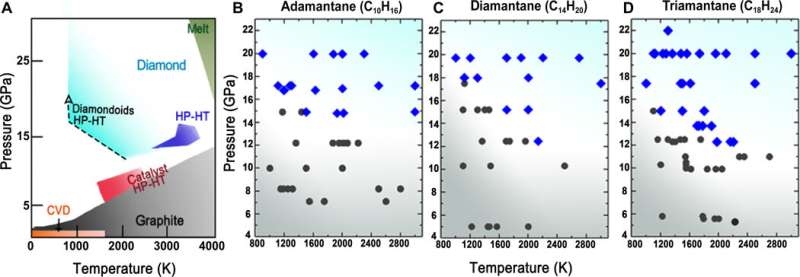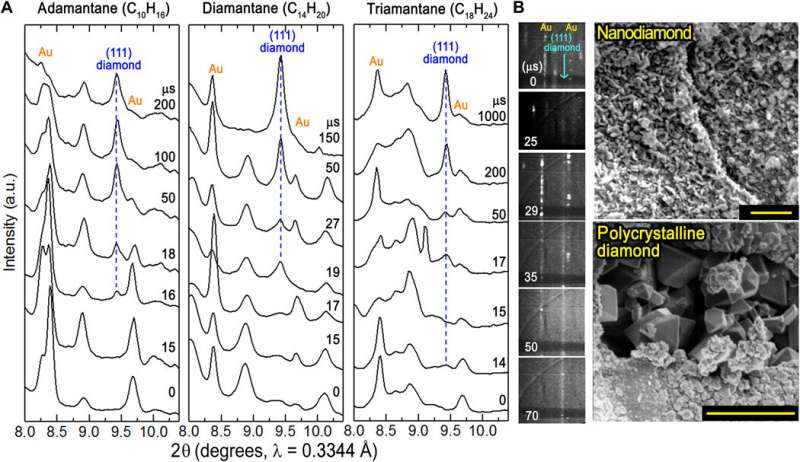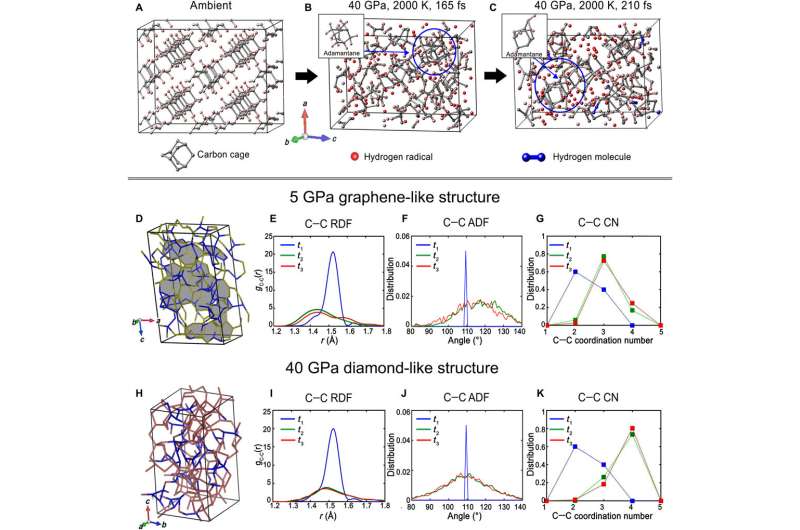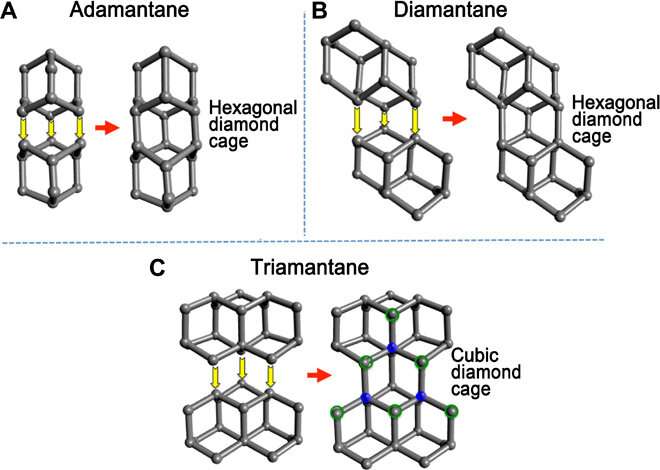March 5, 2020 feature
New carbon-based nanomaterial: Facile diamond synthesis from lower 'diamondoids'
![Identification and characterization of as-synthesized diamond from lower diamondoids. (A) Top: Schematic illustration of laser-heated DAC and sample. Bottom: Transmitted light optical image of a sample (inside a DAC) after laser heating. (B) Representative Raman spectra of quenched–to–ambient pressure diamantane (C14H20) as a function of increasing synthesis temperature at pressures of 5, 15, and 20 GPa. Each Raman spectrum is collected from an individual laser spot with a specific P-T value. a.u., arbitrary units. (C) Scanning electron microscope (SEM) image of diamond formed from triamantane at 20 GPa and ~2000 K. Well-formed diamond grains are embedded in smaller crystalline diamond grains. (D) TEM image of diamond formed from triamantane oriented parallel to the laser-heating beam direction. Scale bars, 1 μm [(C) and (D)]. (E) HRTEM image showing the d-spacing of diamond (111) plane corresponding to 2.06 ± 0.03 Å. Scale bar, 5 nm. (F) Corresponding selected-area electron diffraction pattern with the scale bar of 2 1/nm. (G) EELS from a diamond grain representing nearly full sp3 hybridization of the diamond formed from triamantane (see fig. S3 for SEM and EELS of graphite flake and fig. S4 for energy-dispersive x-ray spectrum of diamond and XRD patterns and SEM images of gold nanoparticles). Credit: Science Advances, doi: 10.1126/sciadv.aay9405 Facile diamond synthesis from lower diamondoids](https://scx1.b-cdn.net/csz/news/800a/2020/facilediamon.jpg)
In a new report published in Science Advances, Sulgiye Park and a research team in geological sciences, materials and energy sciences, advanced research and advanced radiation sources in the U.S. and Beijing, China, developed a carbon-based nanomaterial with exceptional properties. They used new "diamondoids" as a promising precursor to develop laser-induced, high-pressure and high-temperature diamonds. The lowest pressure and temperature conditions to yield diamonds in the study were 12 GPa at approximately 2000 K and 900 K at a pressure of 20 GPa, respectively. The work showed a substantially reduced transformation barrier compared with diamond synthesis using conventional hydrocarbon allotropes. Park et al. credited the observations to structural similarities and the full sp3 hybridization of both diamondoids and bulk diamond.
The diamond-to-diamond conversion in the work occurred rapidly within 19 µs at 20 GPa. Using molecular dynamics simulations, they showed that dehydrogenation allowed the remaining diamondoid carbon cages to reconstruct themselves into diamond-like structures at high pressure and temperature (P-T). The study successfully mapped the P-T conditions and onset timing of diamondoid-to-diamond conversion to clearly explain chemical and physical factors facilitating diamond synthesis.
Diamond has many excellent properties and is one of the most technically and commercially important materials. Since early attempts to synthesize diamonds in the 19th century, materials scientists have developed concerted efforts to engineer energy-efficient approaches and precursors to generate high-quality diamonds. Due to the high energy barrier for direct transformation of carbon precursors to diamond phase, a reagent is typically required. To understand the underlying mechanisms for diamond synthesis technology, designing a new precursor system for facile diamond synthesis with a reduced energy and time barrier is a critical advancement.

Diamondoids are the smallest form of hydrogen-terminated carbon cages that can be superimposed on the diamond lattice. The materials are made entirely of sp3-hybridized bonds and include other exceptional properties including rigidity, thermal stability and uniformity at the atomic level, relative to bulk diamond. While preceding studies validate the use of diamondoids as promising diamond precursors, scientists seek to understand mechanistic pathways of diamondoid-to-diamond transformation via systematic investigations into the pressure-temperature (P-T) phase. To accomplish this, Park et al. used laser-heated diamond anvil cells (DACs) to explore diamond synthesis from a series of lower diamondoids such as adamantane, diamantane and triamantane without using an additional reagent. The research team observed the transformation of lower diamondoids to diamonds at a substantially reduced energy and temporal barrier, when compared with other (hydro) carbon materials at the lowest P-T boundary. The findings clarify basic properties and mechanisms governing the conversion of hydrocarbons to diamond for energy and time-efficient diamond synthesis.
Upon laser-heating diamondoids at high-pressure, Park et al. observed two distinct phases contributing to the formation of graphite and cubic diamond. At 20 GPa and ~1200 to 2200 K, diamond formed as the dominant product without signs of graphite. The results showed that if the team did not overcome the kinetic barrier of phase-transition through an increased duration of laser-heating or higher temperature, hydrogenated diamond-like amorphous carbon formed alongside diamond. When the team optimized the conditions, diamondoid-to-diamond phase transition occurred directly without graphite formation. Park et al. used transmission electron microscopy (TEM) images to verify diamond formation from triamantane at 20 GPa and 2000 K.

When the scientists compared P-T synthesis diagrams for the lower three diamondoids with conventional materials such as graphite, they observed a much lower temperature threshold for diamond formation. Of the three diamondoids studied, triamantane required the lowest temperature to form diamond at a given pressure. The team also investigated the onset timing of diamond formation by controlling the duration of laser heating for adamantane, diamantane and triamantane. They performed qualitative analysis of the diamond particle size using two-dimensional X-ray power diffraction (XRD) to show increased diamond grain size with increased laser-heating. The transformation was characterized by a gradual transition from a faint and broad diffraction line typical of a nanometer-sized diamond to form narrow and spotty lines at longer times characteristic of grain growth in polycrystalline diamond.
The team also used ad initio molecular dynamics (AIMD) simulations to support the experimental results and confirmed the diamondoid-to-diamond transformation pathway. The radial distribution function of the carbon-carbon bond length and angular distribution function of the C-C-C angle accompanied the structural transformation. The scientists noted increased three-fold C-C coordination and decreased two-fold coordination—away from graphite-like features. At an elevated pressure of 40 GPa, 80 percent carbon atoms showed four-fold coordination to indicate a shift towards a diamond-like structure. All observations thereafter were consistent with diamond formation.

Park et al. credited the similarities between lower diamondoids and bulk diamond to clarify the reduced energy barrier observed for diamond formation compared with conventional carbon allotropes. The AIMD calculation also showed that diamondoids held a specific 'memory' of the bulk diamond structure at high P-T. Among the lower diamondoids investigated, the team noted triamantane to require the lowest P-T for diamond formation. Although both adamantane and diamantane required at least three specifically oriented carbon frameworks to form a cubic diamond structure, only two triamantane carbon frameworks required to be linked to grow into extended cubic diamond. The presence of quaternary carbon atoms and surrounding tertiary carbon atoms within the triamantane structure further facilitated this process.

In this way, Sulgiye Park and colleagues showed diamondoids as promising candidates for diamond synthesis. The work offers an energetically superior pathway to form diamond on the order of microseconds, without additional reagents that may alter the purity of the resulting diamond. The results detailed the basic properties and mechanistic pathways affecting the facile conversion of hydrocarbon-to-diamond. The work indicate a promising use of diamondoids for facile diamond synthesis and to investigate light-emitting defects in diamonds for a variety of technical applications across quantum physics to biological sciences. The energy- and time-efficient precursors can be doped or functionalized with targeted defect elements for scientists to better understand and discover color center (crystal defect) containing diamonds.
More information: Sulgiye Park et al. Facile diamond synthesis from lower diamondoids, Science Advances (2020). DOI: 10.1126/sciadv.aay9405
W. H. Taylor. Structure and Properties of Diamond, Nature (2008). DOI: 10.1038/159729a0
T. M. Willey et al. Observation of quantum confinement in the occupied states of diamond clusters, Physical Review B (2006). DOI: 10.1103/PhysRevB.74.205432
Journal information: Science Advances , Nature , Physical Review B
© 2020 Science X Network




















